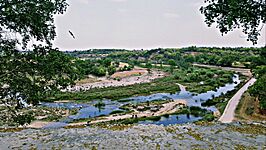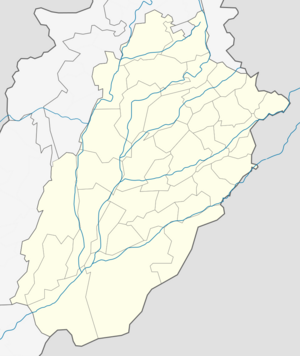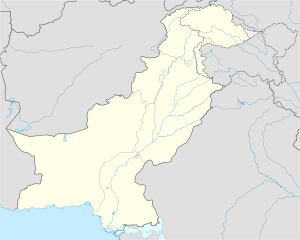Attock facts for kids
Quick facts for kids
Attock
اٹک
Campbellpur
|
|
|---|---|
|
City
|
|
|
From top left to right: Attock city view, Attock Fort, Attock River near Akhori, Attock Bridge
|
|
|
Location in Punjab, Pakistan
|
|
| Country | |
| Province | |
| Division | Rawalpindi |
| District | Attock |
| Established | 4 April 1904 |
| Incorporated | 1978 (Renamed to Attock) |
| Government | |
| • Type | District Administration |
| Elevation | 355 m (1,165 ft) |
| Population
(2023 census)
|
|
| • City | 176,544 |
| • Rank | 60th, Pakistan |
| Time zone | UTC5 (PST) |
| Postal code span |
43600
|
| Area code(s) | 057 |
Attock (Punjabi, Urdu: اٹک), once known as Campbellpur, is a city in Punjab, Pakistan. It is located not far from Pakistan's capital city, Islamabad. Attock is the main city of the Attock District. It is the 36th largest city in Punjab by population. It is also the 61st largest city in the whole country.
The city of Attock was founded in 1908. It was built a few miles southeast of the older, historic city of Attock Khurd. Attock Khurd was established by the Mughal Emperor Akbar in the 1500s. The new city was first named Campbellpur. This was to honor Sir Colin Campbell.
Contents
What's in a Name?
The city was first called Atak-Banāras by the Mughal emperor Akbar. Later, its name was changed to Campbellpur. This was done to honor Sir Colin Campbell. He was a British military leader who helped rebuild the city. In 1978, the city's name was changed back to 'Attock'. This happened because people preferred the original name.
Where is Attock?
Attock is located to the east of the Indus River. It is about 80 kilometers (50 miles) from Rawalpindi. It is also about 100 kilometers (62 miles) from Peshawar. The city is only about 10 kilometers (6 miles) from the Pakistan Aeronautical Complex in Kamra.
Attock's History
Ancient Times
Attock is in the ancient region of Gandhara. Many famous leaders passed through this area. These included Alexander the Great, Mahmud of Ghazni, Timur, Nader Shah, and Babur. They all crossed the Indus River near Attock during their invasions of India.
The Attock Fort was built after Emperor Akbar founded the city. It was finished in 1583. Khawaja Shamsuddin Khawafi, one of Akbar's ministers, oversaw its construction. During the Mughal Empire, Attock was part of the Lahore Subah (a province) of Punjab.
Battles and Empires
Nader Shah passed through Attock when he defeated the Mughals. This battle, called the Battle of Karnal, ended Mughal power in Northern India. The Battle of Attock happened near Attock Khurd on April 28, 1758. It was fought between the Durrani state and the Maratha Empire. The Maratha forces won this battle and captured Attock.
However, the Maratha control did not last long. Ahmad Shah Durrani came to take Attock back. He defeated the Maratha forces at the Third Battle of Panipat. After the Durrani state declined, the Sikhs took over the Attock District. The Sikh Kingdom captured the Attock fortress in 1813 from the Durrani Nawab. Many Kashmiris moved to the Attock plains after Kashmir was occupied by the Sikh Kingdom in 1820.
In February 1849, Attock Khurd (Old Attock) was taken by the British East India Company. They then created the Campbellpur District. After the Indian Rebellion in 1857, the British saw how important this area was. They set up the Campbellpur Cantonment here in 1857–58.
Modern Attock
The Campbellpur Cantonment was established by the British in 1858. The Campbellpur District was formed in 1904. This happened by combining parts of the Jhelum District with parts of the Rawalpindi District. Today, the Attock district has six smaller areas called tehsils. These are Fateh Jang, Hazro, Hasan Abdal, Jand, and Pindi Gheb.
The new city of Campbellpur began in 1908. It was named after Sir Colin Campbell. The old city was near the 16th-century Attock fort. This fort protected the main routes between Central Asia and South Asia. Attock's first oil well was drilled in Khaur in 1915. The Attock Oil Company was also started.
Attock was one of the northernmost points of the Punjab Province during the British rule. People used a common phrase to describe the length of colonial India: "Attock se Cuttack." This meant "from Attock to Cuttack". This phrase was first used to describe the size of the Maratha Empire after they conquered Cuttack in 1750 and Attock in 1758.
After Pakistan became independent in 1947, many Hindu and Sikh people moved to India. At the same time, Muslim refugees from India came to live in Attock. The Government of Pakistan officially renamed Campbellpur to Attock in 1978. The city and its surrounding area are known for having many soldiers in the Pakistan Army.
Education in Attock
Attock is known for its good education system. In 2019, it was ranked 3rd out of 146 districts in Pakistan for the quality of education. For school facilities and buildings, it was ranked 17th.
Some of the educational places in Attock include:
- Fazaia Degree College, Attock
- Government Graduate College, Attock
- Government College for Women, Attock
- Allied School, Attock
- FG Public High School
- University of Education Attock Campus
- Fazaia Inter College
- Army Public School & College, Attock
- Government Polytechnic Institute, Attock
- Beacon Light English Model Secondary School
- COMSATS University Islamabad
- Air University Aerospace and Aviation Campus Kamra
- Punjab College, Attock
Notable People
Climate
Attock has a humid subtropical climate (Köppen: Cwa). This means it has hot and humid summers. Its winters are cold to mild.
Sports
- Indus Golf Club
- PAC Golf Club
Images for kids
See also
 In Spanish: Attock para niños
In Spanish: Attock para niños








